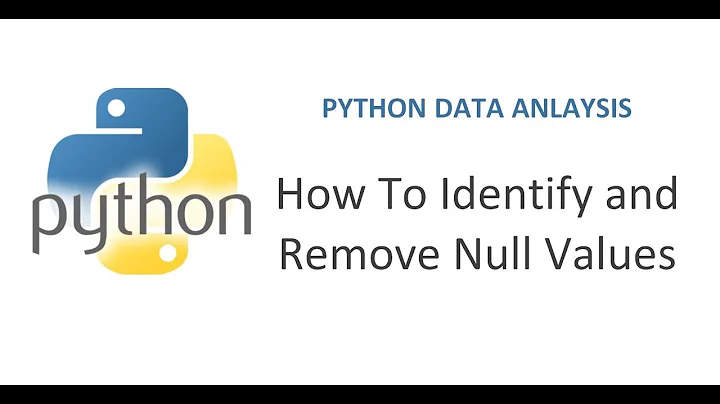remove None value from a list without removing the 0 value
Solution 1
>>> L = [0, 23, 234, 89, None, 0, 35, 9]
>>> [x for x in L if x is not None]
[0, 23, 234, 89, 0, 35, 9]
Just for fun, here's how you can adapt filter to do this without using a lambda, (I wouldn't recommend this code - it's just for scientific purposes)
>>> from operator import is_not
>>> from functools import partial
>>> L = [0, 23, 234, 89, None, 0, 35, 9]
>>> filter(partial(is_not, None), L)
[0, 23, 234, 89, 0, 35, 9]
Solution 2
A list comprehension is likely the cleanest way:
>>> L = [0, 23, 234, 89, None, 0, 35, 9
>>> [x for x in L if x is not None]
[0, 23, 234, 89, 0, 35, 9]
There is also a functional programming approach but it is more involved:
>>> from operator import is_not
>>> from functools import partial
>>> L = [0, 23, 234, 89, None, 0, 35, 9]
>>> list(filter(partial(is_not, None), L))
[0, 23, 234, 89, 0, 35, 9]
Solution 3
Using list comprehension this can be done as follows:
l = [i for i in my_list if i is not None]
The value of l is:
[0, 23, 234, 89, 0, 35, 9]
Solution 4
@jamylak answer is quite nice, however if you don't want to import a couple of modules just to do this simple task, write your own lambda in-place:
>>> L = [0, 23, 234, 89, None, 0, 35, 9]
>>> filter(lambda v: v is not None, L)
[0, 23, 234, 89, 0, 35, 9]
Solution 5
For Python 2.7 (See Raymond's answer, for Python 3 equivalent):
Wanting to know whether something "is not None" is so common in python (and other OO languages), that in my Common.py (which I import to each module with "from Common import *"), I include these lines:
def exists(it):
return (it is not None)
Then to remove None elements from a list, simply do:
filter(exists, L)
I find this easier to read, than the corresponding list comprehension (which Raymond shows, as his Python 2 version).
Related videos on Youtube
mongotop
BY DAY: Data Engineer. BY NIGHT: I like to hit the gym for a bit and cook some nice traditional Moroccan food. FOR FUN: camping during the weekend, watching movies in the theater and reading outdoors.
Updated on October 02, 2021Comments
-
 mongotop over 2 years
mongotop over 2 yearsThis was my source I started with.
My List
L = [0, 23, 234, 89, None, 0, 35, 9]When I run this :
L = filter(None, L)I get this results
[23, 234, 89, 35, 9]But this is not what I need, what I really need is :
[0, 23, 234, 89, 0, 35, 9]Because I'm calculating percentile of the data and the 0 make a lot of difference.
How to remove the None value from a list without removing 0 value?
-
 mgilson about 11 yearsThe less elegant
mgilson about 11 yearsThe less elegantfilterversion:filter(lambda x: x is not None, L)-- You could get rid of thelambdausingpartialandoperator.is_notI think, but it's probably not worth it since the list-comp is so much cleaner. -
 jamylak about 11 years@mgilson Oh wow I didn't even know
jamylak about 11 years@mgilson Oh wow I didn't even knowis_notexisted! I thought it was onlyis_, I'm gonna add that in just for fun -
 mgilson about 11 years
mgilson about 11 years -
 jamylak about 11 years@mgilson I think under that same assumption I just assumed it didn't exist. I guess you can just use
jamylak about 11 years@mgilson I think under that same assumption I just assumed it didn't exist. I guess you can just usefilterfalseor something depending on the use case -
 mgilson about 11 years@jamylak -- Yeah. My main problem is that
mgilson about 11 years@jamylak -- Yeah. My main problem is thatx > ydoes not implynot x <= yin python because you can do anything in__lt__and__le__, so why shouldx not in yimplynot x in y(especially sincenot inhas it's own bytecode?) -
 jamylak about 11 years@mgilson right, that's a good point, Python isn't perfect though
jamylak about 11 years@mgilson right, that's a good point, Python isn't perfect though -
 jamylak about 11 years+1 Do you recommend the use of
jamylak about 11 years+1 Do you recommend the use of__ne__like that as opposed topartialandne? -
Raymond Hettinger about 11 years@jamylak Yes, it is faster, a bit easier to write, and a bit more clear.
-
 Admin over 9 yearsConsider using the
Admin over 9 yearsConsider using theoperatormodule. -
 Laurent LAPORTE over 7 yearsPlease, give some details information to the OP, and not just a code.
Laurent LAPORTE over 7 yearsPlease, give some details information to the OP, and not just a code. -
med_abidi over 7 yearsI did. What you think?
-
 Laurent LAPORTE over 7 yearsWell, this doesn't answer the OP question. Consider this answer instead: stackoverflow.com/a/16096769/1513933
Laurent LAPORTE over 7 yearsWell, this doesn't answer the OP question. Consider this answer instead: stackoverflow.com/a/16096769/1513933 -
med_abidi over 7 yearsYes you are right. There was a problem with the filter partial.
-
DrMcCleod almost 7 yearsWhat is
__ne__? -
Raymond Hettinger almost 7 years@DrMcCleod The expression
x != yinternally callsx.__ne__(y)where the ne stands for "not equal". So,None.__ne__is a bound method that returns True when called with any value other than None. For example,bm = None.__ne__called withbm(10)returns NotImplemented which as true value, andbm(None)returns False. -
 jamylak over 6 yearsI would prefer Raymonds solution for Python 3, and then the list comprehension for Python 2. But if I did have to go this route, I would rather
jamylak over 6 yearsI would prefer Raymonds solution for Python 3, and then the list comprehension for Python 2. But if I did have to go this route, I would ratherpartial(is_not, None)than this solution. I believe this will be slower (although thats not too important). But with a couple of imports of python modules, no need for a custom defined function in this case -
 jamylak over 6 yearsNot a fan of this at all, the whole advantage you claim with this solution is that the list might be so huge that building duplicate list in memory could be costly. Well then your solution will be even more costly because you're scanning the entire list for
jamylak over 6 yearsNot a fan of this at all, the whole advantage you claim with this solution is that the list might be so huge that building duplicate list in memory could be costly. Well then your solution will be even more costly because you're scanning the entire list forL.count(None)and then you're calling.remove(None)multiple times which makes thisO(N^2)The situation you are trying to solve should not be dealt with in this way, the data should be restructured into a Database or file instead if it's that memory intensive. -
 jamylak over 6 yearsWould be interested if you had a practical example where this answer is the best solution, I tend to think that there would be a better approach in all cases. For example
jamylak over 6 yearsWould be interested if you had a practical example where this answer is the best solution, I tend to think that there would be a better approach in all cases. For examplenumpywould be able to handle this type of operation in a more optimised manner -
 jamylak over 6 yearsThis discussion is getting too abstract now, I don't think you'd be able to give me one real life example in your years of experience where this answer is the correct approach over restructuring the data as i mentioned before.
jamylak over 6 yearsThis discussion is getting too abstract now, I don't think you'd be able to give me one real life example in your years of experience where this answer is the correct approach over restructuring the data as i mentioned before. -
Marc about 6 yearsif only
M = L.filter(None) -
 Qaswed about 5 yearsThis solution is already found in the top answer, or am I missing something?
Qaswed about 5 yearsThis solution is already found in the top answer, or am I missing something? -
Kevin almost 4 yearsTrue, but not all real world situations allow flexibility of transforming the data. For example, pumping "legacy" geospatial data through a one-off analysis on a system without much memory. Another example is programming time vs runtime. Might not care if something takes all night to run so long as it was inexpensive to write. What about if writing a plugin or library? You may not be the one deciding what the data looks like. With this answer, I am bringing attention to considering memory and knowing the data, but I point out it probably does not matter most of the time.
-
Kevin almost 4 yearsBest-case is
O(n). Count n with nothing found. AllNonewould beO(2n). Count == n ops; then each remove comparison is found on the first item, so total comparisons is n. A single None at the end of the list is alsoO(2n). Count is n; one additional pass through the list until None is found in the last position n. So, I think worst-case is when the back half the list is entirely None. I think that isO(n + ((n / 2) + 1)^2). Another real world scenario is embedded systems with tiny amounts of memory. Micropython exists specifically for those. -
Piotr Dobrogost over 3 yearsThat
NotImplementedis true in boolean context is really bizarre. See Make NotImplemented unusable in boolean context Python issue. -
Michel de Ruiter over 3 yearsPython 3.9 says:
DeprecationWarning: NotImplemented should not be used in a boolean context -
ToolmakerSteve over 3 yearsPresumably "# second" needs logic to handle ValueError, indicating there were no more to remove.
-
Kevin over 3 years@ToolmakerSteve, no need the "second" because the end-case logic is covered by only removing the number of
L.count(None)items. It cannot make extra calls toremove. -
ToolmakerSteve about 3 yearsThe custom defined function isn't merely for this case. I wouldn't have defined a function if it were! I'm saying that I find it more readable, in many situations, to say "if exists(something)", instead of saying "if something is not None". Its closer to how I think, and avoids the "double-negative" of saying "not None".
-
 jamylak about 3 yearsI see what you mean about avoiding the double negative, actually in the definition of
jamylak about 3 yearsI see what you mean about avoiding the double negative, actually in the definition ofexistsreturn (it is not None)is a clear way to define it. (maybe I'd remove the brackets but that's just a small thing anyway) -
sfink over 2 yearsIt seems like the in-place approach would be better as
w=0; for e in L: if e is not None: L[w] = e; w += 1; del L[w:]. (Sorry, I don't know how to format that in a comment. You can't really do one-line Python. Thedelis after the loop.) It's in-place and O(n). θ(n) in fact. -
Kevin over 2 years@sfink, that is a viable in-place implementation. That takes the implicit list restructuring out of the List.remove() operation and does it explicitly. I think by switching to
is Noneand using a front and a back pointer, instead of only one, you could get rid of the redundant assignments. The my answer is simply pointing out that sometimes memory size may need to be taken into account, and not only processor operation counts. -
 mongotop over 2 yearsusing pandas is a great idea! Thank you @sedrak and welcome to the platform
mongotop over 2 yearsusing pandas is a great idea! Thank you @sedrak and welcome to the platform





